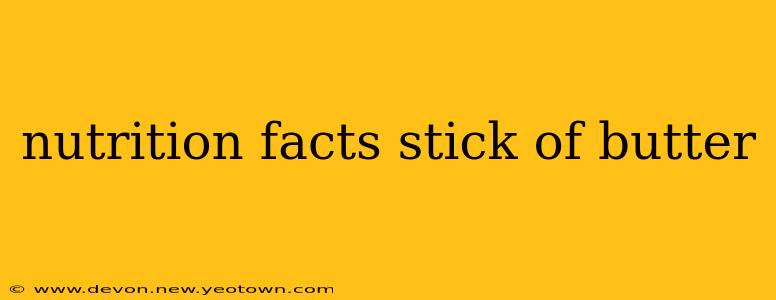Butter. The golden, luscious spread that graces toast, enhances baked goods, and adds richness to countless dishes. But beyond its culinary appeal lies a nutritional profile that's often misunderstood. Let's delve into the facts behind that seemingly simple stick of butter and uncover what's really inside.
Our journey begins with the basics: a standard stick of butter, typically weighing around 113 grams (4 ounces), is a powerhouse of fat. This isn't necessarily a bad thing, as we'll explore, but understanding the type of fat is crucial.
What are the main components of a stick of butter's nutrition?
A stick of butter primarily consists of fat, with smaller amounts of water and milk solids. This fat is largely saturated, with some monounsaturated and polyunsaturated fats as well. Let's break it down further:
-
Fat: This makes up the lion's share of a stick of butter's composition. The majority is saturated fat, which has gotten a bad rap in recent years, but is a necessary part of a balanced diet in moderation.
-
Saturated Fat: This type of fat raises LDL ("bad") cholesterol levels when consumed in excess. However, it's important to remember that not all saturated fats are created equal. Butter contains a variety of saturated fatty acids, some with potentially less detrimental effects than others.
-
Unsaturated Fat: Butter also contains smaller amounts of monounsaturated and polyunsaturated fats, which are generally considered "good" fats. These fats can help lower LDL cholesterol and improve heart health.
-
Cholesterol: Butter is naturally high in cholesterol, another element that's often associated with negative health consequences. However, dietary cholesterol's impact on blood cholesterol levels is less significant than previously believed.
-
Vitamins and Minerals: While not a primary source, butter does contain small amounts of fat-soluble vitamins like vitamin A and vitamin E, along with trace minerals.
How many calories are in a stick of butter?
A standard stick of butter (113 grams) contains approximately 810 calories. This high caloric density stems primarily from its fat content. Portion control is key when incorporating butter into your diet.
Is butter high in sodium?
Interestingly, unsalted butter has virtually no sodium. However, many commercially available brands add salt for flavor and preservation, leading to a significant sodium content in salted butter. Always check the nutrition label for specific sodium levels.
Is butter healthy?
This is a complex question. The answer isn't a simple yes or no. Moderation is key. Butter, in reasonable amounts, can be part of a balanced diet. It provides essential nutrients, adds flavor and texture to meals, and contributes to satiety. However, its high saturated fat and calorie content means it should be consumed mindfully as part of a broader healthy eating plan. Focusing on unsalted butter and using it sparingly can minimize potential negative effects.
What are the different types of butter?
Beyond salted and unsalted, various types of butter exist, including:
-
Sweet Cream Butter: The most common type, made from sweet cream.
-
Cultured Butter: Made from cultured cream, resulting in a tangier flavor.
-
Clarified Butter: Butter with the milk solids and water removed, resulting in a higher smoke point.
-
Ghee: Clarified butter from India, often cooked longer, resulting in a nutty flavor.
Ultimately, butter, like any food, should be enjoyed as part of a balanced and varied diet. Understanding its nutritional composition empowers you to make informed choices about its consumption. Always remember to check the specific nutrition facts on the packaging of your chosen brand for the most accurate information.

